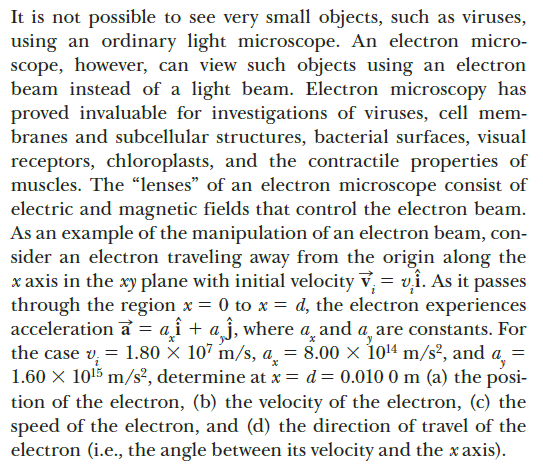It is not possible to see very small objects, such as viruses, using an ordinary light microscope. An electron micro- scope, however, can view such objects using an electron beam instead of a light beam. Electron microscopy has proved invaluable for investigations of viruses, cell mem- branes and subcellular structures, bacterial surfaces, visual receptors, chloroplasts, and the contractile properties of muscles. The “lenses" of an electron microscope consist of electric and magnetic fields that control the electron beam. As an example of the manipulation of an electron beam, con- sider an electron traveling away from the origin along the x axis in the xy plane with initial velocity v, = v,i. As it passes through the region x = 0 to x = d, the electron experiences acceleration a = ai+ aj, where a̟and a are constants. For the case v, = 1.80 × 107 m/s, a̟ = 8.00 × 1014 m/s?, and a = 1.60 x 1015 m/s?, determine at x = d= 0.010 0 m (a) the posi- tion of the electron, (b) the velocity of the electron, (c) the speed of the electron, and (d) the direction of travel of the electron (i.e., the angle between its velocity and the x axis).
It is not possible to see very small objects, such as viruses, using an ordinary light microscope. An electron micro- scope, however, can view such objects using an electron beam instead of a light beam. Electron microscopy has proved invaluable for investigations of viruses, cell mem- branes and subcellular structures, bacterial surfaces, visual receptors, chloroplasts, and the contractile properties of muscles. The “lenses" of an electron microscope consist of electric and magnetic fields that control the electron beam. As an example of the manipulation of an electron beam, con- sider an electron traveling away from the origin along the x axis in the xy plane with initial velocity v, = v,i. As it passes through the region x = 0 to x = d, the electron experiences acceleration a = ai+ aj, where a̟and a are constants. For the case v, = 1.80 × 107 m/s, a̟ = 8.00 × 1014 m/s?, and a = 1.60 x 1015 m/s?, determine at x = d= 0.010 0 m (a) the posi- tion of the electron, (b) the velocity of the electron, (c) the speed of the electron, and (d) the direction of travel of the electron (i.e., the angle between its velocity and the x axis).
Related questions
Question

Transcribed Image Text:It is not possible to see very small objects, such as viruses,
using an ordinary light microscope. An electron micro-
scope, however, can view such objects using an electron
beam instead of a light beam. Electron microscopy has
proved invaluable for investigations of viruses, cell mem-
branes and subcellular structures, bacterial surfaces, visual
receptors, chloroplasts, and the contractile properties of
muscles. The “lenses" of an electron microscope consist of
electric and magnetic fields that control the electron beam.
As an example of the manipulation of an electron beam, con-
sider an electron traveling away from the origin along the
x axis in the xy plane with initial velocity v, = v,i. As it passes
through the region x = 0 to x = d, the electron experiences
acceleration a = ai+ aj, where a̟and a are constants. For
the case v, = 1.80 × 107 m/s, a̟ = 8.00 × 1014 m/s?, and a =
1.60 x 1015 m/s?, determine at x = d= 0.010 0 m (a) the posi-
tion of the electron, (b) the velocity of the electron, (c) the
speed of the electron, and (d) the direction of travel of the
electron (i.e., the angle between its velocity and the x axis).
Expert Solution
This question has been solved!
Explore an expertly crafted, step-by-step solution for a thorough understanding of key concepts.
This is a popular solution!
Trending now
This is a popular solution!
Step by step
Solved in 7 steps
